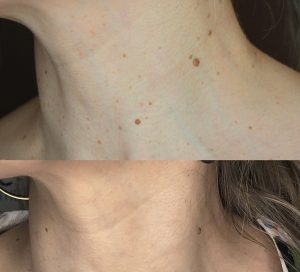


#Multiple skin tags on neck how to#
The most effective way to remove a skin tag is by visiting a professional dermatologist who knows how to remove that skin tag without harming the surrounding tissue or causing scarring of any kind. However, these methods are not safe, nor are they hygienic. Many online resources give detailed instructions on how to remove a skin tag at home. Skin tags are often found on areas of the body that experience friction and the most common areas include the neck, the underarm, the eyelids, and beneath the breasts. They also often develop on pregnant women, diabetics, and those who qualify as obese. Also, those who live an unhealthy lifestyle and eat an unhealthy diet that consistently elevates their blood sugar levels are often more prone to skin tags. Other factors may contribute to the formation of skin tags, including repetitive friction on certain areas of the body.

When they are located in a visible area of the body, they may even make you feel self-conscious. While these tags are harmless, they can be bothersome. Some people are prone to skin tags based on their family history. Skin tags form for various reasons, including aging and genetics. Once the skin tag is treated, it will fall off. Lateef will apply a topical numbing gel to the area and then apply the electrode tip to the skin tag to damage the tissues in the area and burn through to the stalk. ElectrosurgeryĮlectrosurgery involves the use of an electric current to burn off the skin tag. Freezing the skin tag will prevent the skin cells from growing, and eventually, the tag will fall off, typically within a few weeks. A topical numbing cream will be applied as necessary to ensure your comfort during the entire ready of the treatment. Lateef will use liquid nitrogen to freeze off the tag. CryotherapyĪnother method of skin tag removal involves freezing the tag to kill the skin cells. Cutting is a completely safe method because it is performed in our office by a professional who knows how to remove the tag so that it does not cut too deeply into the skin or cause scarring or bleeding. Then, he will carefully use a scalpel or medical-grade scissors to remove the tag from the skin. Lateef will clean the area surrounding the skin tag and then apply a topical anesthetic to numb the area so that you remain comfortable during the treatment. The traditional method of removing skin tags involves using a scalpel or scissors to cut the skin tag off the skin. The primary methods used at our office to remove skin tags include electrosurgery, cryotherapy, and the cutting method. Various methods can help different patients achieve their desired results. There are different ways to remove skin tags from the body. At Orlando Dermatology in Orlando, FL, we offer several different methods of skin tag removal Orlando so that you can finally be rid of those annoying growths for good. While they typically do not cause any pain, they are bothersome, and chances are if you have one, you want it gone. Bhatia so he can evaluate your tags and remove them safely.Skin tags are those annoying, benign growths that appear on different areas of the body but are most common on the neck and arm areas. The best and safest way to remove skin tags is to schedule an evaluation with Dr. No, removing skin tags on your own using home remedies or other techniques can result in serious skin infection and scarring. Most treatments take between 10 and 30 minutes to complete. The length of your treatment depends on how many tags you need to have removed. The procedure may cause a minor stinging sensation when the energy is applied. Skin tags are most commonly treated with a tiny device that emits energy waves to coagulate tissue and prevent blood flow to the tag, eventually causing it to darken and fall off, usually within just a few days. Some studies have suggested they're more likely to occur in people who have a family history of skin tags. Composed of fibers of collagen, blood vessels, and nerve and fat cells surrounded by a layer of skin, skin tags develop as a result of irritation. Skin tags are a common occurrence in people over the age of 40, but they can occur in younger people as well. Skin tags may be referred to by many names, including acrochordon, cutaneous papilloma, fibroepithelial polyps and fibro molluscum. Skin tags typically cause no symptoms unless they're repeatedly rubbed, which can cause itching, pain or bleeding. The most common areas for skin tag formation include the underarms, groin area, eyelids, neck and the area beneath the breasts. Skin tags are tiny overgrowths of skin tissue that protrude on a stalk from the skin surface and commonly form in areas where clothing or overhanging skin rubs and causes irritation.


 0 kommentar(er)
0 kommentar(er)
